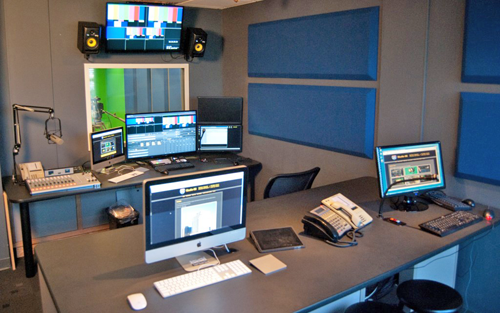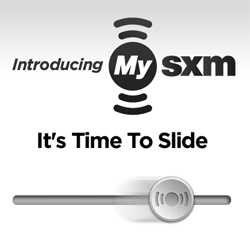 This month’s Q It Up was a shot in the dark to see how much website work was being done by radio producers. Turns out it may not be too many, but the few responses we received show there are definitely some aggressive companies and producers who are not waiting until the last minute to get with the program. And it was a pure coincidence that Dave Foxx’s Production 212 column this month was on this very same subject! He’s certainly one that isn’t going to be left behind on this trend, as are the others below.
This month’s Q It Up was a shot in the dark to see how much website work was being done by radio producers. Turns out it may not be too many, but the few responses we received show there are definitely some aggressive companies and producers who are not waiting until the last minute to get with the program. And it was a pure coincidence that Dave Foxx’s Production 212 column this month was on this very same subject! He’s certainly one that isn’t going to be left behind on this trend, as are the others below.
Sirius/XM is also pushing the envelope as you’ll read about from three producers at the company. Be sure to take the online tour of Al Peterson’s video production studio (link below). And Rich Conway took it to a whole new level and opened his owned website creation company!
Q It Up: With the increasing amount of online streaming, on demand content and greater connection to the audience through website videos, photos and more, there is an increasing need for production pros with website experience -- whether it’s video/graphics editing or content management. This is a natural progression for creative types. As a radio production person, what are you doing to make yourself more valuable as more station groups expand their internet offerings? Are you already involved in creating content for your company’s website(s)? Tell us about it. What are you doing? If you’re editing video, how did you find the transition from audio only to working with both audio and video? What tools are you working with for web content? What are your general thoughts on the subject of traditional radio production people adding website content creation to their list of skills/duties?
Earl Pilkington <copy[at]coastradio.com.au>, “Creative” Copywriter, West Coast Radio Pty Ltd, 97.3 Coast FM/1116 6mm, Mandurah, Western Australia: We are a small provincial radio station in Mandurah, Western Australia, and although we are small, we try to hit it big time with lots of different content to cross all of our listener demos, and clients.
We have a slight advantage that I did radio in the early ‘80s, then went to TV for 12 years as a producer/director, and so I had a lot to fall back on when I came back to radio.
We now do the following on our website (and this is the 4th version of the site since we went on the web):
1. Producing, shooting, editing, video for station events and any guests being interviewed. www.coastlive.com.au/ for our main FM website, and also our AM site is: www.6mm.com.au/, which has slightly less at the moment.
2. Then we have Coast Live TV with our in-house production videos... www.youtube.com/user/CoastLiveFM?feature=watch
3. Soon to start: Video news items. We have just bought our camera and equipment to start producing full HD news items, as well as online video commercials for clients who want to splash the cash a bit.
4. Blog posts for our clients about all forms of media and business, which contains video, podcasts, and soon much, much more. www.coastlive.com.au/info/blog-for-clients
5. We are also in the process of creating a green screen studio for a small budget to start creating a weekly news round-up, in-house video clips, and music sessions with artists.
6. In the works are new video tours of our station, live video streaming of OB’s, and live streaming concerts.
7. We also have 2 station apps, which operate as a fantastic way for our listeners to engage with us - they are incredibly popular, and we are always pushing to try to fit more and more in to the apps with each update.
As far as what tools we are using:
Video: At the moment (until the new gear arrives) we are shooting on DSLR’s, laptop webcams, and small handheld cameras (depending on the look we want for the shoot) and editing with Adobe Premiere.
Website: We are using Joomla, which is okay, if a tiny-bit unstable and not without its quirks.
Audio is always our prime concern for all of these things.
As far as my thoughts on traditional radio people adding content: I have 2 issues with it:
 1. Radio people, at least in my experience, just don’t think in visuals, and it has taken 2 years of constant training, and pushing, cajoling and prodding to get them to the point that they are now, with everything from the website to social media. Pictures have proven to be an incredibly important way of connecting with our listeners, and we now even run competitions based around things like ‘pets’ and ‘costumes’ and ‘food’.
1. Radio people, at least in my experience, just don’t think in visuals, and it has taken 2 years of constant training, and pushing, cajoling and prodding to get them to the point that they are now, with everything from the website to social media. Pictures have proven to be an incredibly important way of connecting with our listeners, and we now even run competitions based around things like ‘pets’ and ‘costumes’ and ‘food’.
2. Without the constant prodding of someone who knows about these things (I don’t mean to brag, but it was me - and now others since hired who are in the know), we were being taken for a ride by supposed ‘website experts’ who really were just out to feather their own nests, and not create compelling content to make people come back - so much so that we now have a digital sales department which works its butt off and makes budget every month - love that!
If you want to know more, or would like an update on the radio station green screen studio - I will be taking pictures and more during its construction, so just let me know.
Until next time - thanks for the opportunity to give feedback - and keep up the great work you guys do - I love it!
Rich Conway <rconway[at]wccc.com>, WCCC-FM, Hartford, Connecticut: I started my own website company and currently have over 300 clients. We do web videos and more. www.connecticutwebsitecompany.com.
Alan Peterson <apeterson[at]radioamerica.org>, Radio America, Washington, DC: Here at Radio America, we designed and built a dedicated video production facility for educational and historic/archival projects [www.videostudio66.com/studio-tour]. We are tricked out with HD cameras, a prompter, greenscreen, a Tricaster switcher, three Final Cut editing computers, and a whole buncha stuff. Our primary use for it is interviewing and recording war veterans of many different eras, and sharing our material both on the web and with the Library of Congress. Secondary use is for hosts who do ‘vanity’ webcasts, and for our summer interns, who use it to develop audio and video skills -- both in terms of production and on-camera performance.

Transitioning to video production for me was a bit clunky, as I came in at the end of tape assembly editing (two VTR decks and a controller, around 1996). But two 8-week video classes at the local public access channel inspired me to learn more. When the inexorable wave of radio consolidation made me rethink my career direction in 1999, I went fulltime into TV production at a local house, and now I’m the de facto video guy here at the network. It seems to me that, if I limited myself only to radio/audio production, I would have been shutting myself out of many potential tangents of career growth; and if radio is going to stay competitive with all other forms of media out there, we have to be as good if not better than everyone else out there doing it.
If I can offer advice, I’d say learn how to do good and fast storytelling with video, even with barebones equipment. The wipes and effects are fun, but it’s like laser overload in a radio promo: ANYBODY can do that, and the buzz is good for only one or two plays.
And if you can’t, just hire me. ;^D
 Michael Scampone <Michael.Scampone[at]siriusxm.com>, Production, SiriusXM Sports, Sirius/XM Satellite Radio, New York: I feel the best way to make yourself more valuable or to maintain your worth, is to progress with technology. An example of that is; stop clogging email boxes, use Soundcloud or Dropbox for demos and when sharing production with co-workers.
Michael Scampone <Michael.Scampone[at]siriusxm.com>, Production, SiriusXM Sports, Sirius/XM Satellite Radio, New York: I feel the best way to make yourself more valuable or to maintain your worth, is to progress with technology. An example of that is; stop clogging email boxes, use Soundcloud or Dropbox for demos and when sharing production with co-workers.
Technology has really caught up to cost, you can get equipment, like high quality USB microphones and video cameras and audio/video editing software on the cheap (cheap enough that your company might foot the bill). These tools are no longer in the thousands of dollars and just for the precious few. I suggest get these tools and learn them, so when your PD or a job listing asks if someone can do it, you are already set.
Finally, as far as imaging online content, I feel what your station/channel posts online is special and a promotion for something further. The sound of the imaging should not be as overwhelmingly ‘radio’, i.e zips zaps stutters and other fx. Stop it, calm down, and make it interesting and unique...
Matt Damrow <Matt.Damrow[at]siriusxm.com>: VO Talent and Sports Imaging Producer, www.mattdamrow.com, SiriusXM Radio, New York: Would you agree that going to the movies has changed since you were a kid? My favorite part about going to the movies is sitting in the audience anticipating a unique and immersive experience. I love film. I love it more than radio. There you have it: The truth. I love it because it engages me in ways audio by itself cannot. Of course, this is not news to you. We live in a YouTube world. In fact, 72 hours of content is uploaded to YouTube every day! Now that’s crazy. But how much of that is GOOD CONTENT? How much of it has value and is compelling? Over the past few years there’s been a growing demand for video content the world over. Studies everywhere demonstrate an increase in audience engagement when video content is added to their experience; making it more immersive.
At SiriusXM we are often developing new ways to enrich the subscriber experience, be it MySXM, On Demand, the SiriusXM App, Backseat TV or more. Shortly after my arrival the reality was staring me in the face. Our subscribers are some of the most discerning consumers of audio entertainment in the country. Not only do they deserve more value for their money, they demand it. This is where my love for film comes in.
Several years ago I took a digital video editing class at the local community college. However, I forgot to check the “audit” box and I ended up with a grade. I didn’t expect it, but I aced the course - which was a surprise to this college dropout. The success encouraged me to proceed with learning digital video production, and my supervisor and department head continue to champion my education. It’s been a few years, but now I have an Associate’s degree in digital filmmaking and a Bachelor’s in screenwriting is due next spring. All the pieces seem to be falling into place. My skillsets are growing on the digital and story-telling levels and my company’s subscribers are demanding more immersive content in our increasingly digitally-driven, social media world. I am in the position of providing this special content SiriusXM will need in the next few years.
And so I produce like I always have. I bring my own brand of creative to the team here at SiriusXM. We aim to continue being an innovative leader in changing times, but it’s necessary to change with those times in order to be said ‘innovative leader’. Before this decade wraps up nearly every car on the road will be connected to the internet. That’s a fact. The way I see it if we’re not providing original audio AND VIDEO content through your car dash someone else will. This is why I encourage producers (Imaging and Production) to start thinking and creating beyond the audio medium. The producer across the street isn’t waiting for you to catch up. In fact, they’re looking for you to drop the ball. They want your listeners now. Don’t let that happen. Take theirs! And while you’re at it start using the word “audience”.
This doesn’t mean we ignore the audio-only mode of entertainment. It remains a viable means of engagement. It’s balancing the ways we communicate with our audience that matters; knowing how, where and when to communicate with them. That’s an effective route to a successful audience relationship. You need to pull them in just like at the movies! This is a time for creative producers to naturally evolve by combining their current expertise with a newly acquired one. Doing so will make you valuable in the workplace and job market. So go take a class in digital video. Or go to the movies! They’re a perfect place to start, in my humble opinion, when you’re in the business of communication and entertainment.
Gregory Best <studio[at]gregorybest.com>, Best Voice Over, www.gregorybest.com: I have not done any website voiceover production for radio stations. As a freelance voiceover artist, I’ve done a number of voiceover production jobs for several non-radio websites. A number were repeat jobs to keep the sites up to date which is important especially for radio stations.
Perhaps radio stations need to get with it and use more audio production and good voiceover on its websites. It is an audio medium, yet I’ve encountered little audio on radio station websites. Go figure. It is a good place to maintain a station’s brand and image. Good audio enhances the viewer/listener’s overall experience since they are seeing the site as whole with the graphics, other content and audio. This is also good for the visually impaired who you do not want to exclude.
Having worked on air in the late ‘60s through 1980 and as a PD, I find radio not quite as creative and fun today. Websites and the programming both need to be engaging to keep the listener interested and involved in the content. There is much more competition in the digital age for the listener’s attention. It takes a bit more work and creativity to get the job done.
New technologies and shifts in consumer’s wants are changing a number of industries, not just radio. My wife was a professional photographer (Hasselblad 2 2/14” medium format professional cameras and film) for more than 25 years, and she has seen digital completely change photography as a profession. She got out as most of her colleagues have in recent years.
Both radio and voiceover have changed in major ways as well as a result of digital technology, and radio even more so with deregulation. I am sure it will all change again someday. We need to keep our eyes (and ears) open for the subtle shifts and major trends.
Ricky Bonnet <Ricky.Bonnet[at]siriusxm.com>, Producer Sports Imaging & Programs, SiriusXM Satellite Radio, New York: As someone working for a major media company at SiriusXM Satellite Radio whose main format happens to be radio, I feel as if the future of radio production lies in incorporating web, video and social networking skills to the everyday repertoire of the production team. I have already seen instances of video production and sharing of content being implemented into our service.
One of my co-workers who is already moving forward and really looking to spearhead this initiative has started recording, editing and posting content from hosts onto our various YouTube pages. His goal is to create unique content for not only our current subscribers, but also for potential subscribers who haven’t yet joined our service. It is also a good way for our PR staff to share the footage of celebrity guests (sports, music, etc.) appearing in-studio with major media outlets, with the hopes that they will use our footage, therefore promoting the company. Studies have shown that human beings prefer audio/video stimulation rather than just audio stimulation, so this is a step towards that precedent.
To me, I believe the future of this company (and radio for that matter) is a format that incorporates audio and video into the service. You are already starting to see this with radio shows such as the Dan Patrick Show, Mike and Mike in the Morning and On-Air with Ryan Seacrest. Imagine a service that essentially gave the subscriber not only access to radio shows audibly in the car, app or radio at home, but also the ability to watch those same shows on their phone, tablet, computer or television in the comfort of their home! SiriusXM Satellite Radio can serve as not only a satellite radio company but also as a T.V. network! There is actually a program on the market by the name of Tri-Caster currently on the market that can make this a reality. It gives you the ability to set up multiple cameras in the studio and through a mixing board, cut from camera to camera seamlessly. In addition to that, you can add graphics such as tickers, labeling and the ability to blue screen in backgrounds, helping add a polished production quality to the broadcast. Not only would subscribers be willing to pay extra for the video service, but it would enable our sales team to entice potential advertisers to buy spots based on promotion of their products through video ads to play during each show.
Through the initial steps we are taking now in implementing video into our production tasks, I believe that the end result of a dual audio/video service may not be too far away. I can already see various members of our production team polishing their video and web skills in anticipation of the next step of the evolution of this company. What’s important is to not be satisfied with mediocrity. We need to look towards the future, harnessing the technology of the mediums around us. Will there be growing pains? Of course there will be! But that shouldn’t deter us from trying to make our industry better. At some point in every visionaries career there were detractors telling them they were wasting their time. But the only way to achieve progress is to move forward and get up when you fall.
As of now, we are not only trying to figure out a system of doing things, we are also attempting to show company brass how implementing more video into our services can lead to the growth of SiriusXM Satellite Radio technologically and subscriber-wise. For someone like myself who wants to not only grow my skill set, but also, my standing within the company, I really believe that the industry of radio as it exists today is in need of a serious renaissance. The only way we will get there is by pushing the boundaries of the technology that powers this medium and thinking out the box, as we move towards the next stage of our industries evolution.
♦
